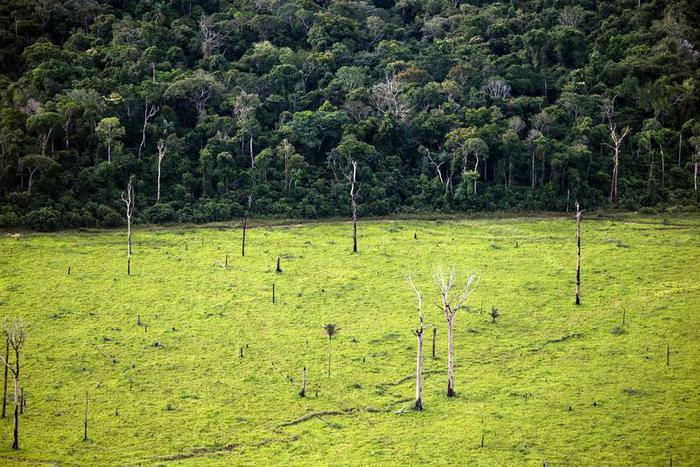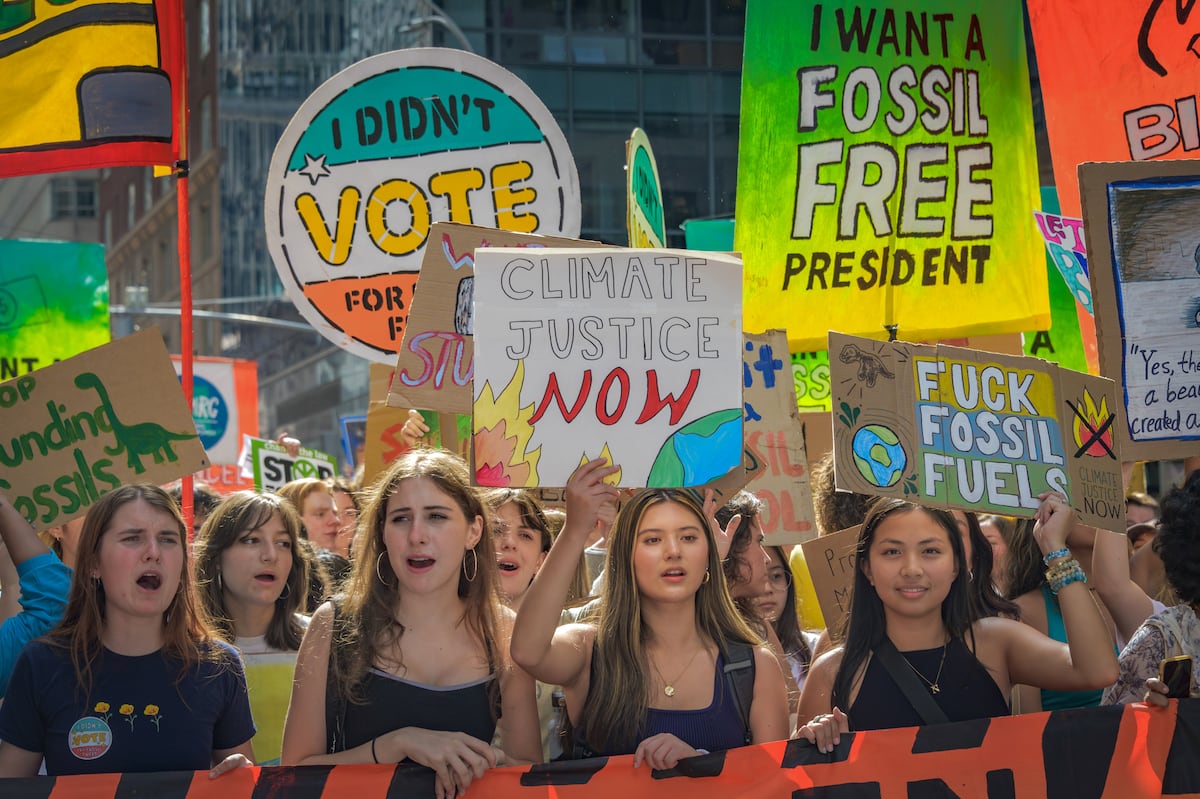Enlarge image
The so-called »Action Zone« at the climate summit: the conference focused on technical details of the Paris Treaty
Photo: Christoph Soeder / dpa
Boris Johnson should perhaps have saved himself the nice idea with James Bond.
Because when the British Prime Minister compared the mission of the delegates with that of the film hero on the first day of the UN climate conference, he raised the bar of expectations.
Very high.
Saving the world in just 12 days - it couldn't be done.
In the end, the conference also lasted significantly longer, the "Glasgow Climate Pact" was adopted with a delay of 24 hours.
This 26th meeting of almost 200 countries was the largest climate conference ever - despite rising corona numbers, despite two years of pandemic.
Over 30,000 participants traveled to Glasgow, almost 40,000 were registered for the conference.
From the start, the climate movement saw only “greenwashing” and “blah blah” in the negotiations; the British government stylized the meeting as a “decision-making summit”, not least for domestic political reasons.
The result from Glasgow now also polarized: The conference was important for the technical details of the implementation of the Paris Agreement - many diplomats also see it this way - but Glasgow was not a second Paris.
"Success lies in the details, not in the big words," says Christina Voigt, lawyer and delegation from Norway in Glasgow.
The adjectives, tables and pointed formulations are decisive for how well global climate diplomacy will function in the coming decades.
"And that is what the 1.5-degree target ultimately depends on," says the lawyer.
It has been six years since the world climate agreement was adopted by almost 200 countries under the French presidency.
Thousands of delegates celebrated the success in the suburb of Le Bourgé.
Then the struggle for the details began.
The last five climate conferences since Paris have shown that large projects can be announced lightly, but that it is difficult to translate them into concrete political action.
World rescue, as all the participants learned in Glasgow, is more bureaucratic than expected.
The resolutions are correspondingly technical and complex in detail.
The most important are:
Greenhouse gases - how do we squeeze the emissions curve?
The Glasgow Pact "recognizes" that the consequences of climate change are much less with a temperature increase of 1.5 degrees than with 2 degrees. However, the final document only mentions an "effort" to meet this goal. Nevertheless, the document shows for the first time the
45 percent reduction in emissions required to
reach the
1.5 degree limit
by 2030 compared to 2010. The agreement made in Paris in 2015 not to allow global warming to "if possible" rise above 1.5 degrees was therefore strengthened in Glasgow - an important signal, especially to countries particularly threatened by climate change.
The federal states have decided to
improve
their
climate targets for 2030
as early as next year
. Above all, those countries have to step up that have so far not submitted any or particularly bad updates to their climate plans. So far, many larger countries had mainly presented long-term goals for climate neutrality by the middle of the century without always demonstrating in a comprehensible manner how they ensure that they actually achieve them. The delegates in Glasgow agreed that the necessary transparency will be made up for next year.
For the first time ever, a
commitment to a longer-term phase-out of coal and the reduction of fossil subsidies
was made in the final document of a climate summit
.
Even in the world climate treaty of Paris there is no indication that the burning of fossil fuels must end, so the final document from Glasgow goes decisively further here.
However, this article was weakened again and again at the last moment - most recently from “exit” to “dismantling”.
Transparency rules: who keeps their promises?
The countries are "encouraged"
to align
their
future
climate plans
to five years.
This allows you to determine how quickly you want to reduce your emissions.
For the first time, this is now regulated in a uniform time frame.
It is comparable to who does how much.
But a ten-year target is not ruled out either.
A review of how close the international community is to the goals of the Paris Agreement also takes place every five years - but some countries had also asked for an annual balance sheet to be drawn up shortly before the climate conference.
That should now be "commissioned".
Nevertheless, the delegates also agreed on a more
transparent review of
the national climate plans that they submit to the UN.
From 2024 onwards, states will have to report their emissions balance every two years - i.e. how much CO₂ or methane their coal kilns or steelworks have blown into the air.
In the Federal Republic of Germany, the German Emissions Trading Authority is already collecting this data on a regular basis.
The industrialized countries must now also regularly look into the books on the subject of climate aid and explain in which time periods exactly which sums will flow to projects or governments.
Carbon markets: can climate protection be acted upon?
Even if the Paris Climate Agreement is now around six years old, parts of the rules have not yet been formulated. One of them is Article six of the treaty. This should regulate how countries
act among themselves
can. If country A builds a wind farm or reforests, it can sell the resulting climate benefits to country B in the form of a certificate. The latter can then offset the greenhouse gases saved on its own balance sheet and has to implement less climate protection in its own country. However, several countries intended not only to sell the climate effect, but also to evaluate it in their own country - climate protection threatened to be counted twice, but only to be achieved once. In Glasgow, the states have now agreed on a compromise: There should be new CO2 credits, so-called Paris Agreement Ajustment Units (PAAU). With them, the sellers undertake not to value the certificates sold twice. However, there was no regulation for the so-called voluntary market,here the standards are still unclear.
Climate protection certificates already existed in the previous Paris agreement, the Kyoto Protocol.
China in particular had urged to
continue trading
these old and largely
useless certificates
.
A compromise now stipulates that only those certificates that were created after 2013 may be traded.
Climate aid: How does the support work?
As early as 2019, the richer countries had promised to transfer the poorer
100 billion US dollars annually
from 2020 onwards
for the conversion to renewable energies and adaptations to climate change. The world community now states "with great regret" that the promised sum has still not been reached. The delegations from Germany and Canada had drawn up a timetable in Glasgow on how the money can be raised at least in the coming years, which is now referred to in the final document.
From 2025, the sums for
adaptation
to climate change are to be doubled compared to 2019.
Above all, poorer countries, which are already severely affected by the consequences of climate change, have urged concrete commitments for such aid.
The countries want to agree on a “global adaptation target” in the next two years.
Loss and damage: who pays the bill?
For the first time in Glasgow, the industrialized countries are
paying more attention to
the issue of
loss and damage caused
by extreme weather conditions as a result of climate change.
The states want to initiate a process for "technical assistance".
As storms, droughts and floods increase, the question of responsibility for climate change becomes more and more present.
In the Paris Agreement, under pressure from the industrialized countries, the states excluded the word "compensation" for the consequences of climate change, which historically were primarily caused by the richer states - they do not want to be held liable for the damage.
Germany, Scotland and Wallonia are the only ones who have pledged specific funds for this so far.
Conclusion: success or failure?
The "Glasgow Climate Pact" is perhaps not the big hit that many would have liked to see. But a single conference cannot solve a human problem - especially not if 200 states with the most varied of interests are involved. However, the countries in Glasgow delivered the technical details of the Paris Agreement. It's not glamorous, but it's important. The world now has a set of rules for the worldwide monitoring of climate-damaging emissions and can measure which countries are making progress in climate protection - and which are not.
This means that not a ton of CO₂ has been saved and compliance with the 1.5 degree target is not guaranteed.
This is what the governments now have to address in their countries.
Whether the new rules and promises from Glasgow will be enough to get companies, investors and politicians in the mood for the transformation into a post-fossil world will only be seen in a few years.


/cloudfront-eu-central-1.images.arcpublishing.com/prisa/DOOQ2YEAZJCSNITR6TA2ARDQT4.jpg)






